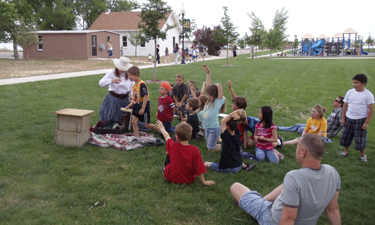 Boardwalk Park affords users spectacular views of the eastern plains and the Rocky Mountains. Located in Windsor, Colorado’s historic center, summer visitors delight in weekly outdoor concerts and frequent festivals that attract thousands. A Boundless playground and recreational lake with swim beach invite boisterous fun that can be seen and heard year-round. Boardwalk Park is an invaluable community asset. There is, however, potential yet unrealized.
Boardwalk Park affords users spectacular views of the eastern plains and the Rocky Mountains. Located in Windsor, Colorado’s historic center, summer visitors delight in weekly outdoor concerts and frequent festivals that attract thousands. A Boundless playground and recreational lake with swim beach invite boisterous fun that can be seen and heard year-round. Boardwalk Park is an invaluable community asset. There is, however, potential yet unrealized.
At the park’s west end, a collection of historic buildings predates the park’s formal incorporation by the town. Collected by generations of Windsor residents committed to preserving the town’s history, the buildings are not original to the site. Members of the local historical society dedicated time and expense to their care and interpretation until 2003, at which time they were formally deeded to the town, along with the land where they were situated. Centennial Village, as it was called, was absorbed by the larger development efforts of Boardwalk Park. It was determined at that time that the historic structures should remain as they were and that the town would continue to care for and interpret them to the public.
Fast forward 10 years. The Town of Windsor Museum at Boardwalk Park, as it has been renamed to acknowledge its location, suffers a disconnect from the rest of the park, ironically delineated by a concrete sidewalk that separates the east and west halves of the park, two very distinct programmatic spaces. The museum struggles to attract the vibrant visitation the eastern portion of the park enjoys. Opportunities for synthesizing programs and facilities across “the sidewalk” have not been identified.
While the intent of this article is not to provide a dissertation on ways to attract museum visitors, it does attempt to explain to readers how sensitive landscape planning can bridge the disconnect between two public spaces.
Museum and park staff understood from the beginning the important role landscape would play in the future success of the site. Early deliberations envisioned the museum portion of the park as a “living history” site where the visitor could figuratively immerse themselves in the past. Theoretically, the landscape would become an extension of the museum requiring a level of curation all its own. Budgetary restraints, staff turnover, and the luxury of time allowed ideas to mature systematically. Underdeveloped concepts and innovation were grafted to core beliefs, while the unessential was allowed the opportunity to fall away. Over the course of 10 years, the museum and park staffs worked collaboratively, and at times excruciatingly, to identify what the landscape should and shouldn’t be.
Rather than perpetuate a dissonance between the museum and the rest of the park, the museum staff approached the landscape design with an eye to blurring the line between play and culture, education, and recreation. The landscape primarily would address the programmatic needs of the space, place the historic sites present in greater focus, and, in some instances, juxtapose the historic character of the space with modern installations, including interactive public art. While some might be concerned about the dilution of the historic significance of the site, staff felt conversely that it might elicit conversation among visitors about the past and present and their interdependence.
Equipped with a stronger sensibility of what the landscape should accomplish, museum staff identified universal design as another guiding philosophy for the decision-making process. With considerations like flexibility and intuitive and equitable use, the landscape will attempt to serve a broad range of users, regardless of physical or cognitive ability. The Town of Windsor Museum has selected landscape designer and planner Robert Peccia & Associates to create the interpretive landscape master plan for summer 2013. Implementation of the plan’s first phase will commence in fall 2013.
Carrie Knight is the Art and Heritage Manager with Parks, Recreation, and Culture for the Town of Windsor, Colorado.
Across the Sidewalk
April 1, 2013, Department, by Carrie Knight

